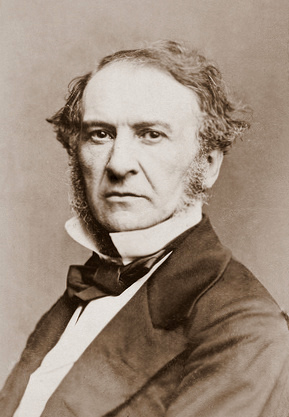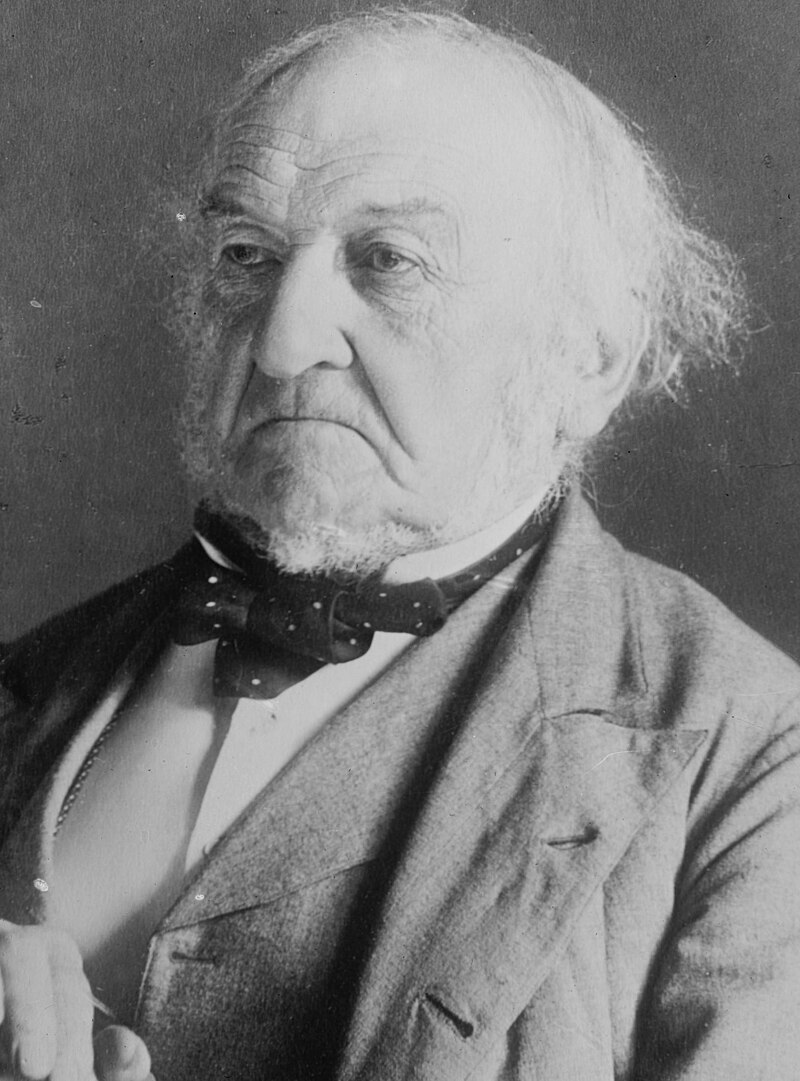by Susan Flantzer
© Unofficial Royalty 2018

photographed by John Mayall, 1861; Credit – Wikipedia
William Ewart Gladstone served as Prime Minister of the United Kingdom four times during the reign of Queen Victoria: 1868 – 1874, 1880 – 1885, February 1886 – July 1886 and 1892 – 1894. He was born December 29, 1809, at 62 Rodney Street in Liverpool, England, the fourth son and the fifth of the six children of merchant John Gladstone, and his second wife, Anne MacKenzie Robertson, who were both born in Scotland. In 1846, Gladstone’s father was made 1st Baronet of Fasque and Balfour. Gladstone had five siblings. All his brothers were also politicians. Thomas and John were Members of Parliament and Robertson was Mayor of Liverpool.
- Anne MacKenzie Gladstone (1802–1829), unmarried
- Sir Thomas Gladstone, 2nd Baronet (1804–1889), married Louisa Fellowes, had six daughters
- Robertson Gladstone (1805–1875), married Mary Ellen Jones, had eight children
- Captain John Neilson Gladstone, Royal Navy (1807–1863), married Elizabeth Honoria Bateson, had one son Sir John Gladstone, 4th Baronet who succeeded his cousin, Sir John
- Robert Gladstone, the 3rd Baronet
- Helen Jane Gladstone (1814–1880)
Gladstone was educated from 1816–1821 at a preparatory school at the vicarage of St. Thomas’ Church in Sefton, Merseyside, England, close to his family’s home, Seaforth House. He then attended Eton College and finally Christ Church, Oxford, where he read Classics and Mathematics. Gladstone served as President of the Oxford Union, where he developed a reputation as an orator. Later in life, he used those oratorical skills in the House of Commons.

Gladstone in the 1830s’ Credit – Wikipedia
In 1832, Gladstone started his more than 60-year career in Parliament when, at the age of 23, he was elected as a Tory Member of Parliament. Over the years, he changed his political party membership three times: Tory (1828–34), Conservative (1834–46), Peelite (1846–59) and Liberal (1859–98). He served four times in the Cabinet as Chancellor of the Exchequer: 1852 – 1855, 1859 – 1866, 1873 – 1874 and 1880 – 1882.

Catherine Gladstone, 1883; Credit – Wikipedia
On July 25, 1839, Gladstone married Catherine Glynne, daughter of Sir Stephen Glynne, 8th Baronet. On the death of Catherine’s unmarried brother Sir Stephen Glynne, 9th Baronet, Gladstone inherited the Glynne ancestral home Hawarden Castle in Hawarden, Flintshire, Wales. Gladstone and Catherine had eight children:
- William Henry Gladstone (1840 – 1891), married The Honorable Gertrude Stuart, daughter of Charles Stuart, 12th Lord Blantyre, had three children.
- Agnes Gladstone (1842 – 1931), married The Very Reverend Edward Wickham, had three children
- The Reverend Stephen Edward Gladstone (1844 – 1920), married Annie Wilson, had five children
- Catherine Jessy Gladstone (1845 – 1850), died in childhood
- Mary Gladstone (1847 – 1927), married Reverend Harry Drew, had two children
- Helen Gladstone (1849 – 1925), Vice-Principal of Newnham College, Cambridge, unmarried
- Henry Neville Gladstone, 1st Baron Gladstone of Hawarden (1852 – 1935), married The Honorable Maud Rendel, daughter of Stuart Rendel, 1st Baron Rendel, no children
- Herbert John Gladstone, 1st Viscount Gladstone (1854 – 1930), married Dorothy Paget, daughter of Sir Richard Paget, 1st Baronet, no children
Two of Gladstone’s sons, William and Herbert, were Members of Parliament, as was a grandson William Glynne Charles Gladstone, who was killed in action in 1915 during World War I. Along with Gladstone’s father, Sir John Gladstone, 1st Baronet, making four successive generations of Members of Parliament.

Gladstone Family Group by Herbert Rose Barraud albumen cabinet card, 1870s-1900s NPG x5979 © National Portrait Gallery, London (Gladstone, Catherine with their children and their spouses)
In 1867, Gladstone was elected Leader of the Liberal Party. Then, in 1868, the Conservative Prime Minister Edward Smith-Stanley, 14th Earl of Derby died in office and Benjamin Disraeli succeeded him as Prime Minister and became Gladstone’s main opponent. In the 1869 elections, the Liberal Party won a majority and Gladstone became Prime Minister for the first time. From 1868 through 1885, Gladstone and Disraeli switched back and forth as Prime Minister, with Gladstone serving three times and Disraeli serving two times. At the time of Disraeli’s death in 1881, Gladstone was currently Prime Minister and would continue in that term until 1885. He served two more times as Prime Minister: February 1886 – July 1886, and 1892 – 1894.

Gladstone in 1877 photographed by William Currey; Credit – Wikipedia
While Disraeli got along famously with Queen Victoria, Gladstone did not. Disraeli’s strategy with Queen Victoria was flattery. One of his famous quotes was, “Everybody likes flattery and, when you come to royalty, you should lay it on with a trowel.” Queen Victoria wanted to have an imperial title and Disraeli worked to pass a bill that made her Empress of India. The Queen found Gladstone too loud, too excitable, and uncompromising. She was incensed that Gladstone believed the monarch served with the permission of Parliament. Gladstone even lectured Queen Victoria on her duties – one of which, in his opinion, was that she should appear more often in public. He did not understand that the Queen became extremely stubborn when coerced, and as a result, they were often at odds.
In early 1894, the 84-year-old Gladstone retired from active politics, almost blind and hard of hearing. Gladstone had his last audience with Queen Victoria on February 28, 1894, he chaired his 556th Cabinet meeting on March 1, 1894, and then gave his last speech in the House of Commons. He resigned as Prime Minister on March 2, 1894. Today, the monarch would heed the Prime Minister’s advice as to who should succeed him or her. However, Queen Victoria did not ask Gladstone who should succeed him but sent for Archibald Primrose, 5th Earl of Rosebery, who was serving in Gladstone’s Cabinet as the Foreign Secretary. Gladstone would have advised Queen Victoria to send for John Poyntz Spencer, 5th Earl Spencer.

Gladstone in old age, photographed by GG Bain; Credit – Wikipedia
Gladstone remained in the House of Commons until 1895. He was not offered a peerage, having earlier declined an earldom. Gladstone holds the distinction of being the oldest person to form a government – aged 82 at his appointment in 1892 – and the oldest person to be Prime Minister – 84 years old at his resignation in 1894.
William Ewart Gladstone died on May 19, 1898, at his country home Hawarden Castle at the age of 88. He had been cared for by his daughter Helen who had resigned from her position as vice-principal at Newnham College, a women-only constituent college of the University of Cambridge, to care for her elderly father and mother. Queen Victoria gave permission for a state funeral and a burial at Westminster Abbey. The Prince of Wales (the future King Edward VII) and the Duke of York (the future King George V) served as pallbearers and the Princess of Wales (the future Queen Alexandra) and the Duchess of York (the future Queen Mary) attended the funeral. Gladstone’s wife, Catherine Gladstone died two years later on June 14, 1900, at the age of 88, and was buried next to her husband.
- Victorian Web: Gladstone’s Funeral in Westminster Abbey, and Tributes Paid on This Occasion
- YouTube: Gladstone’s Funeral (1898)

Gladstone and his wife’s grave in Westminster Abbey; Credit – Wikipedia
This article is the intellectual property of Unofficial Royalty and is NOT TO BE COPIED, EDITED, OR POSTED IN ANY FORM ON ANOTHER WEBSITE under any circumstances. It is permissible to use a link that directs to Unofficial Royalty.
Works Cited
- Baird, Julia. Victoria The Queen. Random House, 2016.
- De.wikipedia.org. (2018). William Ewart Gladstone. [online] Available at: https://de.wikipedia.org/wiki/William_Ewart_Gladstone [Accessed 1 Aug. 2018].
- En.wikipedia.org. (2018). Catherine Gladstone. [online] Available at: https://en.wikipedia.org/wiki/Catherine_Gladstone [Accessed 1 Aug. 2018].
- En.wikipedia.org. (2018). William Ewart Gladstone. [online] Available at: https://en.wikipedia.org/wiki/William_Ewart_Gladstone [Accessed 1 Aug. 2018].
- Erickson, Carolly. Her Little Majesty: The Life of Queen Victoria.Simon and Schuster, 1997.
- Hubbard, Kate. Serving Victoria: Life In The Royal Household. Harper Collins Publishers, 2012
